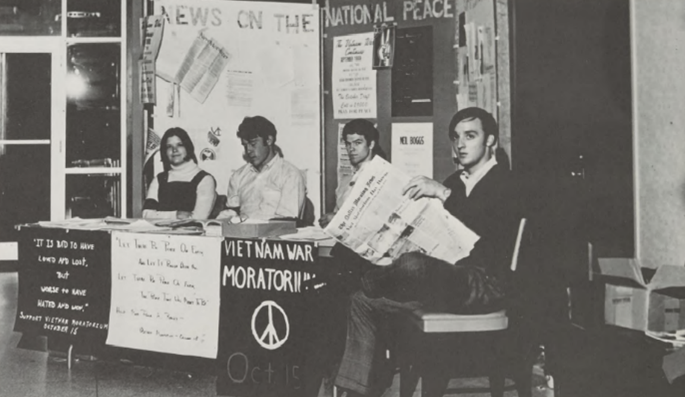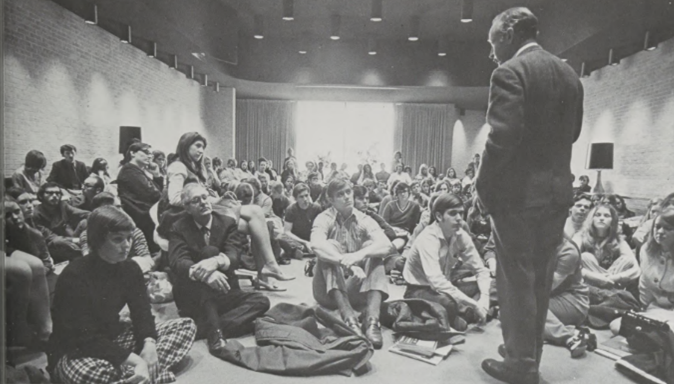TCU’s Vietnam Anti-War Adaptation
How would you feel if you went to school and there were bomb threats almost every week at a place where you are supposed to feel safe? This was the situation at Texas Christian University toward the end of the Vietnam War. The 1960s and 1970s were a very turbulent time in America. While 2.7 million men and women served in Vietnam, there was a lot of strife and conflict on the home front as well.[1] The rise of the antiwar movement exacerbated existing social and cultural divisions as the movement was brought to the forefront of every American’s mind. The TCU community mirrored the growing negative feelings toward the war.

The Horned Frog, 1970, page 47
The antiwar movement has been prominent in all US wars, but it really became widespread and prevalent during the Vietnam War. The movement exacerbated existing divisions in the nation, including the division between Republicans and Democrats during and after the World Wars.[2] The antiwar movement also grew out of the Civil Rights Movement and its reliance on public protest. A lot of young people believed that protesting government actions, that they deemed immoral, was a good and just thing.[3] The foundation of division in America with politics and the Civil Rights Movement paved the way for a large anti-war movement. This knowledge of how the antiwar movement started allows one to understand how it spread into all areas of the country.
TCU students expressed a large variety of attitudes about the war. As American involvement in the war started to dwindle, some students at TCU called to end ROTC at the school because they believed it was unnecessary and unneeded.[4] Broad TCU support for the war followed declining national opinion. As the Skiff noted, “Public support of the Vietnam encounter continue[d] to decline,” throughout the war.[5] People around the country increasingly sided with the antiwar movement. They started to feel that the American image was devolving into a “sad and somber individual.” This and other anti-war speech are featured on a page of the Skiff right next to a cadet sergeant major in ROTC who argued that the ROTC program is necessary.[6] This visual division in the campus paper mirrors the increasingly visible divisions seen across the country.

The Horned Frog, 1970, page 46
On October 15, 1969, TCU students that supported the antiwar movement held a peace moratorium in solidarity with the national Moratorium to End the War in Vietnam. In preparation for this event, many students adorned blue buttons that read “work for peace” with a white dove on them.[7] Some administrators opposed any protest that would disrupt campus life and suggested that it would bring a “depression” to campus that mirrored the feelings held across America.[8] TCU actions even made their way to Vietnam when a TCU alumnus who was a GI in Vietnam had the Skiff shipped over to him. Disgusted by what he read, he wrote back to TCU to reprimand all the students who were involved in this moratorium and called them all “idiots.”[9] The divide that was so evident across the country started to come to light at TCU.
Toward the end of the war, TCU, like many other places around the country, experienced bomb threats including one directed at ROTC.[10] This threat toward ROTC really made tensions rise at and around TCU because it was only two days after the fire was set to the University of Kentucky ROTC building that started so much turmoil across the country. During one week, firemen had to come to campus three times for a fire and two bomb threats.[11] Some of these crimes went unpunished as they were often made from a public phone line, but some students were caught and expelled for their crimes. All these threats illustrated how divided the TCU community was, paralleling the feeling held across the country.

The Horned Frog, 1971, page 143
The antiwar movement of the Vietnam War expanded upon other existing divisions in the country. Texas Christian University, a campus that historically had many pro-war programs, still felt the anti-war movement in many ways. The culture of TCU mirrored that of America at large throughout the war with declining approval and support of the war and growing support of the antiwar movement.
[1] “Vietnam Department of US Veteran’s Affairs Military Service History Pocketcard,” U.S. Department of Veteran’s Affairs Military Service, Vietnam: U.S. Department of Veterans Affairs Military Service History Pocketcard (https://www.va.gov/OAA/pocketcard/m-vietnam.asp).
[2] Maurice Isserman and Michael Kazin, Chapter 10 “The Fall of the Great Society,” America Divided: The Civil War of the 1960s (New York: Oxford University Press, 1999), 187-203.
[3] Adam Garfinkle, Telltale Hearts: The Origins and the Impact of the Vietnam Antiwar Movement (New York: New York University Press, 1951), 77-79.
[4] J.D. Fuller, “ROTC Attacked,” The Skiff, March 7, 1969, Special Collections, Mary Couts Burnett Library, Texas Christian University.
[5] J.D. Fuller, “To Arms or Not?” The Skiff, March 18, 1969, Special Collections, Mary Couts Burnett Library, Texas Christian University.
[6] J.D. Fuller, “To Arms or Not?” and Brian Black, Letter to the editor, both in The Skiff, March 18, 1969, Special Collections, Mary Couts Burnett Library, Texas Christian University.
[7] Joe Kennedy, “Viet Moratorium set for Wednesday” The Skiff, October 10, 1970, Special Collections, Mary Couts Burnett Library, Texas Christian University.
[8] “Protest?” The Skiff, May 16, 1969, Special Collections, Mary Couts Burnett Library, Texas Christian University.
[9] Tay Wise, “Moratorium Participants ‘Idiotic,’” The Skiff, November 21, 1969, Special Collections, Mary Couts Burnett Library, Texas Christian University.
[10] Johnny Livengood, “Bomb Threats Continue,” The Skiff, May 8, 1970, Special Collections, Mary Couts Burnett Library, Texas Christian University.
[11] Rita Miller, “City Firemen Bombed-out after three campus calls,” The Skiff, March 29, 1977, Special Collections, Mary Couts Burnett Library, Texas Christian University.
For Further Reading
Garfinkle, Adam. Telltale Hearts: The Origins and the Impact of the Vietnam Antiwar Movement. (New York: New York University Press, 1951).
This book gives great detail into the origins of the war and antiwar movement and the effects that each had on the country and its culture.
Isserman, Maurice and Michael Kazin, America Divided: The Civil War of the 1960s. (New York: Oxford University Press, 1999).
This book is a great insight into how America became so heavily divided in the post WW2 era and why it stayed divided through Vietnam.
DeBendetti, Charles. An American Ordeal: The Antiwar Movement of the Vietnam Era. (New York: Syracuse University Press, 1990).
This is yet another great insight into the antiwar movement and America during the Vietnam War that really dives into the specific groups and how each group contributed to the collective.